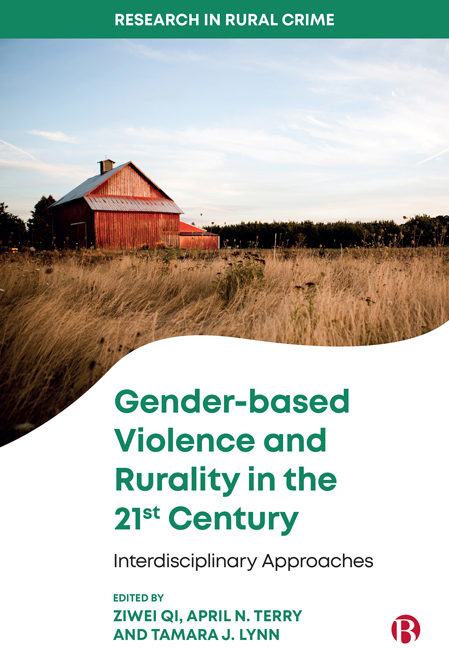Book contents
- Frontmatter
- Contents
- Series Preface
- List of Figures and Table
- List of Abbreviations
- Glossary
- Notes on Contributors
- Foreword
- 1 Understanding Rurality and Gender-based Violence
- PART I Rurality and Gender-based Violence
- PART II Beyond the Rural/Urban Divide: Critical Issues in Gender-based Violence
- PART III Access to Rural Justice: Economic Consequences and Policy Implications
- Index
2 - What is ‘Rural’, Anyway?
Published online by Cambridge University Press: 20 January 2024
- Frontmatter
- Contents
- Series Preface
- List of Figures and Table
- List of Abbreviations
- Glossary
- Notes on Contributors
- Foreword
- 1 Understanding Rurality and Gender-based Violence
- PART I Rurality and Gender-based Violence
- PART II Beyond the Rural/Urban Divide: Critical Issues in Gender-based Violence
- PART III Access to Rural Justice: Economic Consequences and Policy Implications
- Index
Summary
Introduction
Studies have consistently shown that gender-based violence (GBV) manifests in unique, and often more severe, patterns in rural United States communities. Intimate partner violence (IPV) in rural communities has been shown to be more frequent, severe and lethal than in urban communities (Bloom et al, 2014; Edwards, 2015; Reckdenwald et al, 2018; DuBois et al, 2019). Gallup-Black (2005), comparing trends in homicide rates from 1980 to 1999, found that family and intimate partner homicide (IPH) rates increased in rural counties, while IPH decreased in semi-urban and urban communities and familial and non-domestic homicides decreased in all community types. In the IPV context, rural survivors report higher levels of sexual abuse compared to physical abuse than urban survivors (Edwards, 2015).
Studies suggest that rural communities experience higher rates of general sexual violence than urban communities; the most recent federal data reports a rate of 41.1 rape victims per 100,000 inhabitants in nonmetropolitan counties compared to 34.2 in metropolitan counties (Federal Bureau of Investigation, 2019). There is a dearth of research on commercial sexual exploitation in rural areas (Aguirre et al, 2017). One study of practitioners who worked with at-risk youth and/or in the criminal justice system in the southern United States found that almost half of all practitioners had worked with a child who had experienced sexual exploitation or trafficking (Cole and Sprang, 2015). Robinson and Ryder (2014) studied teen relational violence in ruralities from both a psychodynamic, sociological and critical perspective. Utilising focus groups in Cape Cod, Massachusetts – a region characterised by rural and small-town economies – they found youth perceptions of violence being everywhere (for example, home, school and social media). Relational violence was a ‘normal’ part of their lives, demonstrating that rural youth relational violence is a public health issue (Robinson and Ryder, 2014).
There is clear evidence of a high GBV prevalence in rural communities, and more research is needed to examine rural patterns of GBV and to test rural-specific GBV prevention interventions. However, before examining these dynamics, scholars and practitioners must determine what rurality is and how to operationalise it. This chapter will discuss commonly used measures of rurality, present a case example to illustrate the utility of continuous measures of rurality, and conclude with a discussion of future directions.
- Type
- Chapter
- Information
- Gender-based Violence and Rurality in the Twenty-first CenturyInterdisciplinary Approaches, pp. 17 - 29Publisher: Bristol University PressPrint publication year: 2023



